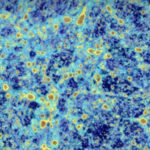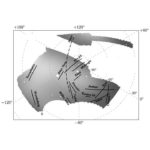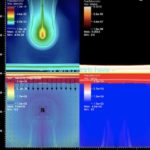Dan Rosplock from Virginia Tech writes that Large-scale simulations could shed light on the ‘dark’ elements that make up most of our cosmos. By reverse engineering the evolution of these elements, they could provide unique insights into more than 14 billion years of cosmic history.
Dark Energy Survey Releases First Three Years of Data
Today scientists from the Dark Energy Survey (DES) released their first three years of data. This first major release of data from the Survey includes information on about 400 million astronomical objects, including distant galaxies billions of light-years away as well as stars in our own galaxy. “There are all kinds of discoveries waiting to be found in the data. While DES scientists are focused on using it to learn about dark energy, we wanted to enable astronomers to explore these images in new ways, to improve our understanding of the universe,” said Dark Energy Survey Data Management Project Scientist Brian Yanny of the U.S. Department of Energy’s Fermi National Accelerator Laboratory.
Supercomputing How First Supernovae Altered Early Star Formation
Over at LBNL, Kathy Kincade writes that cosmologists are using supercomputers to study how heavy metals expelled from exploding supernovae helped the first stars in the universe regulate subsequent star formation. “In the early universe, the stars were massive and the radiation they emitted was very strong,” Chen explained. “So if you have this radiation before that star explodes and becomes a supernova, the radiation has already caused significant damage to the gas surrounding the star’s halo.”
Video: Dark Matter – Detecting Gravity’s Hidden Hand
“One of today’s great challenges in physics is to observe individual dark matter particles coming in from the galaxy and striking particles on Earth. This talk presents the evidence for dark matter and introduces one of the most ambitious efforts to discover interactions of dark matter particles, using tons of cryogenic liquid in a deep underground laboratory.”
New iBook brings us 72 Beautiful Galaxies
A new iBook by Dr. Stephen Perrenod looks at 72 Beautiful Galaxies. With a Foreword written by our own Rich Brueckner from insideHPC, the iPad “book” offers an interactive way to explore the universe. “In 72 Beautiful Galaxies we take you on a trip from relatively near to very far away in the universe, with images of 72 galaxies – and beyond that you will also see hundreds of galaxies as they are found in clusters.”
Video: How Argonne Simulated the Evolution of the Universe
In this Chigago Tonight video, Katrin Heitmann from Argonne National Lab describes one of the most complex simulations of the evolution of the universe ever created. “What we want to do now with these simulations is exactly create this universe in our lab. So we build this model and we put it on a computer and evolve it forward, and now we have created a universe that we can look at and compare it to the real data.”
XSEDE Powers Research into Dark Matter
Researchers are using XSEDE supercomputer resources to advance a new model for explaining dark matter in the universe.










